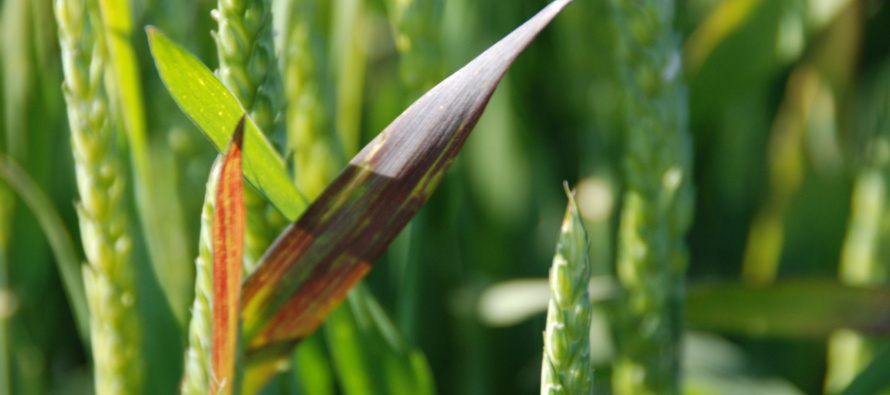Wheat Disease Update: April 22, 2017

Related Articles
- Rice Variety Trial Results For 2010, Plus Rice Research Report 0
- Evaluation of Peanut Prescription Rx Program in Mississippi 0
- Spring Nitrogen Fertility Suggestions for Wheat 0
Latest Tweets
With so little wheat planted in the state, calls reporting wheat diseases have been few and far between this season. Over the past week I have observed the Official Variety Trial locations for the purposes of rating the diseases present (Beaumont, Brooksville, Fittler, Newton, Raymond, Starkville, Stoneville). Honestly, the biggest issue this year was a lack of vernalization due to prolonged periods of warmer than normal weather and therefore those particular varieties will not produce a head. Major vernalization issues were observed at Beaumont (southern MS), Newton and Starkville. At the Beaumont location approximately 60% of the varieties observed will not produce a head.
Second biggest issue to consider has to do with fungicide timing. Based on crop growth stages throughout MS, and considering the majority of the wheat I have observed over the past week, all wheat is at a stage where a fungicide application is no longer legally allowed due to label restrictions. Cut off for fungicide applications is essentially Feekes 10.5.4 based on three products that have a label pre-harvest interval as late as the completion of flowering (10.5.4). ALL of the wheat in our production area is beyond flowering with most of the wheat having reached ripening stages which would put wheat at Feekes 11.
Leaf rust
I have observed more leaf rust at the OVT locations this year than any recent year in memory. However, not all OVT locations contain leaf rust. Brooksville and Issaquena County have so far had the most leaf rust. The other OVT locations have had sporadic amounts of leaf rust.
Over the past week I have received several calls regarding the occurrence of leaf rust in the commercial crop post-flowering. As the wheat matures additional leaf rust may be observed on flag leaves. However, rarely in our production system is leaf rust a concern. Increased incidence of leaf rust as the crop matures is common and unless the variety planted is extremely susceptible to leaf rust, yield reduction will become a factor. Leaf rust differs from stripe rust in that pustules do not form a pattern and are generally darker orange in coloration. Leaf rust in the lower canopy does not always translate into leaf rust on flag leaves. Leaves in the lower canopy are generally nutrient deficient late in the season and can easily become infected with leaf rust.

Physiological flecking can oftentimes occur as a result of the environment and is not normally an indicator of a rust infection.
Physiological flecking
Post-flowering many flag leaves, depending on the variety involved, develop small yellow spots or flecks. Over the past several weeks I have talked to people concerned that this may be “early rust” or “pre-rust”. The environment or the physiology of some particular wheat varieties can lead to flecks that are not the result of early disease. More often than not the flecking causes concern and does not develop into anything more than an aesthetic malady. The yellow spots are generally 1/32 to 1/16 of an inch in size, do not generally cover much of the leaf tissue and can occur on numerous commercially available wheat varieties.
Stripe rust
Aside from a few reports of stripe rust over a month ago, the incidence of stripe rust in MS has not increased significantly. Stripe rust, much like leaf rust, can increase in incidence and severity as the wheat crop matures. The pustules associated with stripe are generally in a linear patter (stripe) on leaves in the wheat canopy. The sporulation that erupts through the leaf tissue is generally lighter in coloration than leaf rust.
Bacterial leaf streak
Bacterial leaf streak is a common occurrence in years when we receive moisture, in the form of rain or heavy dew, at the time of flowering. The symptoms on leaf tissue appear as elongated, pitted, brown with yellow margins lesion that can measure in size from 1/8 inch to longer than 1.5 inches. No management alternatives are necessary since the disease is caused by a bacterium. The severity of bacterial leaf streak appears to differ between varieties. Over the past week, bacterial leaf streak has been observed on wheat varieties in several of the OVT locations.
Fusarium head blight (scab)
I have not observed any measurable scab this season. The risk associated with scab has been low since the crop is several weeks ahead of normal. In addition, without rain before and during flowering growth stages, scab infection does not occur. Scab produces wheat heads that appear bleached and white in color. The disease can affect a small portion of the head or the entire head. Be mindful that several other issues that include: glyphosate drift, freeze damage, or another malady that separates the stem from the crown of the plant can result in the appearance of a bleached head.
Barley yellow dwarf virus
Based on the mild winter temperatures I think additional areas will be affected by Barley yellow dwarf. The name of this particular disease generally causes confusion. The dwarfing, or shorter plants, are generally observed following infection that occurs shortly after emergence. Later infection at tillering stages generally does not normally reduce plant height. The symptoms associated with BYD as we approach physiological maturity tend to occur as yellow or purple-colored flag leaves.







Let me tell You a sad story ! There are no comments yet, but You can be first one to comment this article.
Write a comment